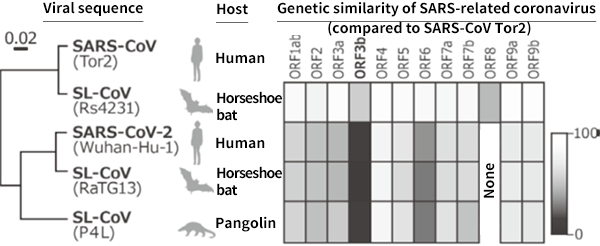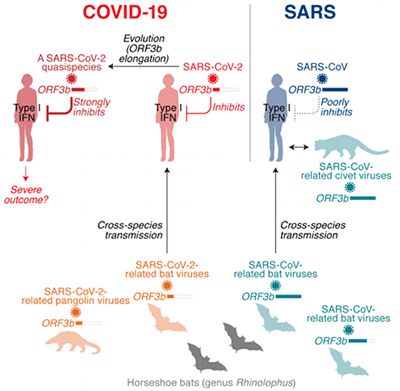Research Results
Technologies that will respond to various viruses. Expected to develop therapeutic agents in the future.
Discovery of genes related to the progression of coronavirus infectionFY2021

- Sato Kei (Associate Professor, Division of Systemic Virology, The Institute of Medical Science, The University of Tokyo)
- J-RAPID
- Collaborative Research Program/Survey Program for Urgent Research (J-RAPID) " Investigation of the roles of SARS-CoV-2-encoding genes on the COVID-19 pathogenesis and viral cross-species transmission ", Principal Investigator in Japan (2020-2021)
Discovery of protein associated with disease progression in COVID-19
It has been reported that one of the characteristics of the new coronavirus infection (COVID-19) is that the "interferon response"*1, which plays a central role in the biological defense against viral infection, is significantly inhibited. However, the mechanism was unknown.
Under Collaborative Research/Survey Program for Urgent Research (J-RAPID), a study group led by Associate Professor Sato Kei discovered the ORF3b protein*2 of a new type of coronavirus (SARS-CoV-2) that inhibits the interferon response.
Considering that the interferon inhibitory activity of the new coronavirus ORF3b protein is stronger than that of ORF3b protein of SARS virus (SARS-CoV) that was prevalent around the world from 2002 to 2003, it is anticipated that this function is likely to be associated with the progression of COVID-19 disease. In addition, Sato Kei et al. exhaustively analyzed the gene sequence of the new coronavirus, which is expanding worldwide. As a result, they discovered the appearance of an ORF3b mutant*3 with enhanced interferon inhibitory activity*4. The results of this research were published in the online version of the British scientific journal "Cell Reports" on September 4, 2020.
*1 Interferon response
One of the body's immune responses that produce a signaling substance called "interferon" that senses and alerts the body to viral infections
*2 ORF3b
One of the viral genes of the new coronavirus (SARS-CoV-2) and SARS virus (SARS-CoV). Previous studies revealed that the SARS virus ORF3b has the ability to suppress the interferon response.
*3 ORF3b mutant
A mutant with elongated gene length of ORF3b
*4 Interferon inhibitory activity
Function of viral proteins that inhibits interferon produced by sensing viral infections
The new coronavirus has stronger interferon inhibitory activity than the SARS virus.
Currently, vaccines and antiviral drugs for the new coronavirus are being developed all over the world. However, many unclear points regarding this virus remain, and the principle of infectious pathology has not yet been understood. On the other hand, based on the analysis results of COVID-19-infected patients, it was pointed out that the production of interferon was significantly inhibited as compared with other respiratory infections such as influenza and SARS. Therefore, inhibition of interferon is considered to be associated with the progression of the pathology of COVID-19.
Sato's research group first compared the lengths of genes in the new coronavirus and in the SARS virus. As a result, they found that the gene length of the ORF3b protein was clearly shorter in the new coronavirus than in the SARS virus (Fig. 1).
The gene for the ORF3b protein of the SARS virus has been known to inhibit interferon production; hence, Associate Professor Sato et al. hypothesized this interferon production inhibition might be related to disease progression. By analyzing the function of the ORF3b protein of the new coronavirus, it was found that the ORF3b protein of the new coronavirus has stronger interferon inhibitory activity than the ORF3b protein of the SARS virus.

Fig. 1 Phylogenetic relationships and genetic similarity of SARS-related coronavirus
The study focused on three genes, ORF3b, ORF6 and ORF8, of which gene sequences are significantly different from those of the SARS virus. Among these, it was found that the gene length of the ORF3b protein was clearly shorter in the new coronavirus than in the SARS virus.
Inhibition of interferon is associated with progression of COVID-19 pathology
Associate Professor Sato et al. analyzed the ORF3b protein of a virus similar to the new coronavirus identified in bats and pangolins, and the sequences of viral strains that are currently prevalent. More specifically, they exhaustively analyzed the sequences of more than 17,000 viruses that are prevalent in the world registered in a public database called "GISAID". As a result, a virus with a sequence in which the length of the ORF3b protein was partially extended was identified in Ecuador. This ORF3b mutant was found to exhibit stronger interferon inhibitory activity than ORF3b of the new coronavirus that is prevalent worldwide (Fig. 2).
From these results, Sato et al. suggested that the ORF3b protein of the new coronavirus has strong interferon inhibitory activity, and this may be associated with the pathophysiology of COVID19. They also found that the ORF3b mutant that appeared during the epidemic enhanced interferon inhibitory activity.
At present, however, only two such mutants have been detected in the more than 17,000 sequences analyzed. Moreover, evidence of increased pathogenicity of the new coronavirus has not been detected. Thus, Sato et al. believes it is extremely unlikely that such a mutant will appear and become a virulent strain. However, with the spread of the epidemic, it has been becoming apparent that various mutations are accumulating in the virus. Considering that it cannot be denied that mutants related to exacerbation of the disease, such as ORF3b mutants, may appear; it is believed that changes in the viral sequence should continuously be observed in the future.

Fig. 2 The ORF3b protein of the new coronavirus is expected to be associated with the progression of the pathology of COVID-19.
The interferon inhibitory activity of the new coronavirus-related viral protein ORF3b is significantly higher than that of the SARS virus-related viral protein ORF3b. It was also found that among the new coronaviruses that are currently prevalent, mutants with enhanced interferon activity have emerged due to partial extension of the ORF3b gene length.
Hope for the development of transmission-blocking technologies and therapeutic agents that can treat any viral infection
Although the new coronavirus is said to have spread across species from bats to humans, only a few cases have been transmitted from bats to humans. In the future, Associate Professor Sato plans to elucidate how these differences in transmission and pathogenicity occur by comparing the genomes of viruses and conducting cell biology experiments. In particular, COVID-19 has led to rapid progress in open science: The virus has been immediately identified from infected persons, and the genome sequence has been released. Also, papers will be shared without awaiting peer review. As a result, research is expected to be accelerated. In the future, it is hoped that technologies that can prevent the transmission of any virus from wild animals to humans and therapeutic agents that stop the development of pathogenicity will be developed.
- Life Science
- Research Results
- Japanese
